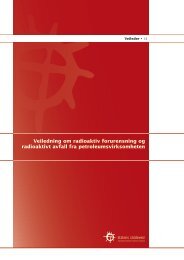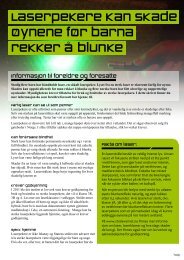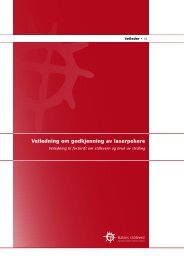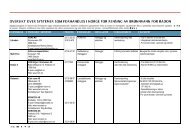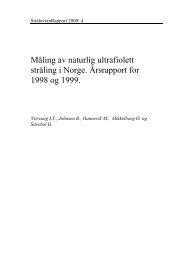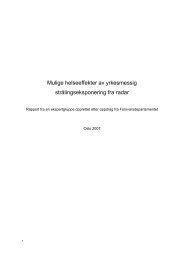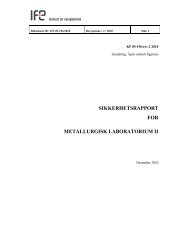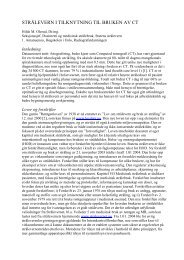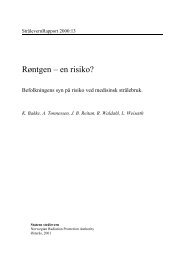Indoor Tanning in Norway - Statens strålevern
Indoor Tanning in Norway - Statens strålevern
Indoor Tanning in Norway - Statens strålevern
Create successful ePaper yourself
Turn your PDF publications into a flip-book with our unique Google optimized e-Paper software.
1.1 History of <strong>in</strong>door tann<strong>in</strong>g<br />
The first commercial tann<strong>in</strong>g devices were<br />
s<strong>in</strong>gle mercury arc lamps, often caus<strong>in</strong>g severe<br />
sunburn and acute eye damage due to very<br />
high UVB irradiation. In <strong>Norway</strong>, Nemko AS<br />
has performed mandatory safety test<strong>in</strong>g and<br />
national approval of electrical equipment to be<br />
marketed <strong>in</strong> <strong>Norway</strong> from 1933 until 1992.<br />
The safety test<strong>in</strong>g did not <strong>in</strong>clude radiation<br />
safety. Accord<strong>in</strong>g to their register, mercury arc<br />
sunlamps were sold <strong>in</strong> <strong>Norway</strong> from 1937 (30).<br />
On the tann<strong>in</strong>g market world wide, small<br />
devices with fluorescent tubes were<br />
commercially available <strong>in</strong> the 1960s, with<br />
spectral UVB represent<strong>in</strong>g up to 5 % of the<br />
output (1).<br />
The first tann<strong>in</strong>g devices <strong>in</strong> <strong>Norway</strong> were the<br />
mercury arc sunlamps, sold from 1937.<br />
The first whole body tann<strong>in</strong>g model appeared<br />
<strong>in</strong> <strong>Norway</strong> <strong>in</strong> 1972, and s<strong>in</strong>ce 1982 most<br />
tann<strong>in</strong>g models were equipped with fluorescent<br />
lamps.<br />
A whole body tann<strong>in</strong>g device common <strong>in</strong><br />
<strong>Norway</strong> from the late 1980s.<br />
10<br />
Due to a grow<strong>in</strong>g concern world wide about<br />
the carc<strong>in</strong>ogenic potential of UVB <strong>in</strong> the 1980s<br />
and 1990s, the UV output of low-pressure<br />
fluorescent lamps was shifted towards UVA<br />
(1). <strong>Indoor</strong> tann<strong>in</strong>g was therefore often called<br />
“UVA tann<strong>in</strong>g”. Though, they still emitted<br />
some UVB, which is crucial for <strong>in</strong>duction of a<br />
deep, persistent tan. Also high-pressure lamps<br />
produc<strong>in</strong>g large quantities of long-wave UVA<br />
(>335 nm) were marketed, often <strong>in</strong><br />
comb<strong>in</strong>ation with low-pressure fluorescent<br />
lamps. The high-pressure lamps can emit up to<br />
10 times more UVA than natural sun. In<br />
<strong>Norway</strong> it was restricted to a lower level by the<br />
national regulations.<br />
From the late 1990s fluorescent lamps emitt<strong>in</strong>g<br />
UV that mimic tropical sun with a higher level<br />
of UVB, around 4 %, has become more<br />
common world wide.<br />
A modern tann<strong>in</strong>g device approved for<br />
cosmetic use <strong>in</strong> <strong>Norway</strong> <strong>in</strong> 2003.<br />
2 Regulations<br />
The Norwegian Radiation Protection Authority<br />
<strong>in</strong>itiated a process for regulat<strong>in</strong>g <strong>in</strong>door<br />
tann<strong>in</strong>g devices <strong>in</strong> the late 1970s due to the<br />
high <strong>in</strong>cidence of sk<strong>in</strong> cancers <strong>in</strong> <strong>Norway</strong> and<br />
the many cases of acute sunburn after us<strong>in</strong>g the<br />
mercury arc sunlamps. It was also desired to<br />
exclude the high-pressure lamps with extreme<br />
UVA radiance. The process was <strong>in</strong> parallel<br />
with Swedish sunbed regulations.<br />
2.1 First regulation, 1983<br />
The first Norwegian regulations were issued 1<br />
July 1983 with a two year transition time (28).



